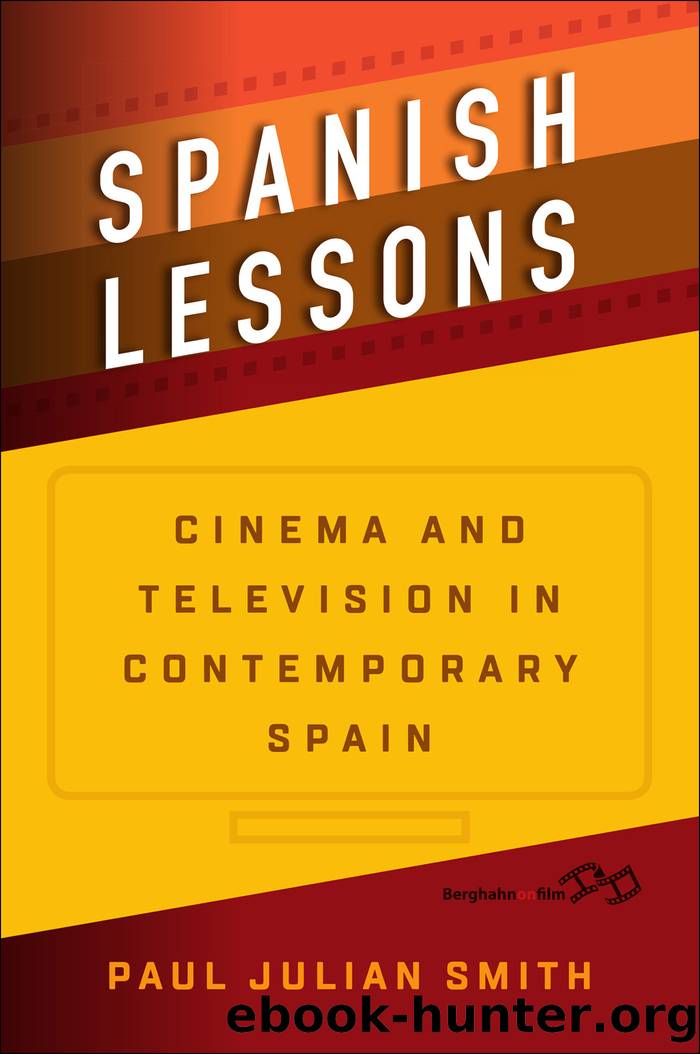Spanish Lessons by Paul Julian Smith

Author:Paul Julian Smith [Smith, Paul Julian]
Language: eng
Format: epub
Publisher: Berghahn Books
Published: 2017-01-15T00:00:00+00:00
CHAPTER 6
Televisual Properties
The Construction Bubble in Three TV Series
Brick Fever
The construction bubble of the 2000s, with its grotesque swelling and traumatic puncture, remains perhaps the biggest social and political problem facing Spain in the twenty-first century. And its causes and effects are complex to elucidate, with commentary stretching over multiple disciplines from economics and statistics to political science.
What I will suggest in this chapter is that one neglected medium to reflect on this phenomenon, still so deeply felt in Spain, is that of television. Strikingly, while no feature film has to my knowledge engaged directly with the question of real estate development in the millennium (although Ãlex de la Iglesiaâs La comunidad [âCommon Wealthâ] of 2000 was an early gesture in that direction), at least three TV series have done so.
As we shall see, these shows are as varied in genre (ranging from farcical comedy, via musical drama, to quality short-run narrative) as they are in cultural cachet (low, medium, and high, respectively). Moreover while the first two series were shot for and shown on a generalist free to air network, the third was intended for a specialist subscription service. It thus follows that, taken together, with their divergent genres, registers, and processes of production, distribution, and reception, the three series will reveal differing perspectives on a single phenomenon, perspectives that are directed toward varied demographic fragments of the Spanish population.
One characteristic of television as a medium is precisely this continuing (indeed unending) worrying away at social problems in real time and in collaboration with a mass audience. It is a process to which John Ellis in Seeing Things: Television in the Age of Uncertainty (2002, 78â81) gave the name âworking through.â The nature of TV, then, is to offer multiple versions or visions of topics that engage its diverse audience, even as it adapts itself in turn (unlike feature film once more) to that audienceâs shifting response.
Yet television might seem ill adapted to the analysis of social issues. As John Corner writes in Critical Ideas in Television Studies, the small screen is generally thought to focus on the affective questions âHow does it look?â and âHow does it feel?â rather than the analytical ones âIs it true? Is it false?â (1999, 113). Yet, as Corner himself acknowledges throughout his book, if TV is indeed biased toward vision and sensation, still the pleasures and knowledges offered by the medium are complex, especially in the genre of long-form fiction. Moreover I will suggest in this chapter that televisual emotion (engaged in different ways by each series) is by no means indistinguishable from cognition. As Martha Nussbaum has also suggested (2001), emotion, however dangerous and unruly it may be by nature, can in certain circumstances constitute a form of cognition, a way of finding out about the world around us. These series are thus, in Nussbaumâs phrase once more, âupheavals of thought,â entertainments that delight, surprise, and disturb their respective publics and thus provoke both the recognition of self and the discovery of others.
Download
This site does not store any files on its server. We only index and link to content provided by other sites. Please contact the content providers to delete copyright contents if any and email us, we'll remove relevant links or contents immediately.
| Coloring Books for Grown-Ups | Humor |
| Movies | Performing Arts |
| Pop Culture | Puzzles & Games |
| Radio | Sheet Music & Scores |
| Television | Trivia & Fun Facts |
The Kite Runner by Khaled Hosseini(5085)
Gerald's Game by Stephen King(4584)
Dialogue by Robert McKee(4326)
The Perils of Being Moderately Famous by Soha Ali Khan(4171)
The 101 Dalmatians by Dodie Smith(3454)
Story: Substance, Structure, Style and the Principles of Screenwriting by Robert McKee(3399)
The Pixar Touch by David A. Price(3369)
Confessions of a Video Vixen by Karrine Steffans(3247)
How Music Works by David Byrne(3190)
Fantastic Beasts: The Crimes of Grindelwald by J. K. Rowling(2995)
Harry Potter 4 - Harry Potter and The Goblet of Fire by J.K.Rowling(2992)
Slugfest by Reed Tucker(2944)
The Mental Game of Writing: How to Overcome Obstacles, Stay Creative and Productive, and Free Your Mind for Success by James Scott Bell(2847)
4 - Harry Potter and the Goblet of Fire by J.K. Rowling(2657)
Screenplay: The Foundations of Screenwriting by Syd Field(2576)
The Complete H. P. Lovecraft Reader by H.P. Lovecraft(2514)
Scandals of Classic Hollywood: Sex, Deviance, and Drama from the Golden Age of American Cinema by Anne Helen Petersen(2467)
Wildflower by Drew Barrymore(2445)
Robin by Dave Itzkoff(2387)
